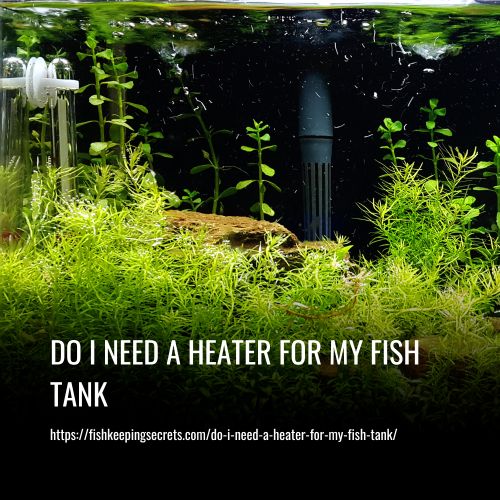Do I Need A Heater For My Fish Tank?
This post contains affiliate links. As an Amazon Associate, we earn from qualifying purchases.
The answer to this question depends on the type of fish you have and their native environment. Generally, if your fish come from tropical or warm-water environments, then a heater is necessary to maintain a consistent temperature in your tank. This is because most tropical fish are sensitive to changes in water temperature and require a specific range to stay healthy.
On the other hand, if you have cold-water fish such as goldfish, a heater may not be essential, but it’s still important to keep an eye on the water temperature and make adjustments as needed.

How Do I Know if My Aquarium Heater is Working?
Testing the functionality of an aquarium heater can be difficult by simply touching the water. Here’s my solution.
1. Check the Heater Light:
One important thing to keep in mind when checking your fish tank heater is the heater’s light. While most heaters have a light that indicates when it’s on, some models may have a body design that partially covers the light from certain angles.
If you’re trying to check whether or not your heater is working properly, it’s crucial to make sure that this indicator light turns on. If it doesn’t, there may be an issue with the heater itself and it might be time to consider getting a replacement.
2. Use a Thermometer:
If you want to ensure that your fish tank heater is working properly, it is recommended to use a thermometer. First, measure the temperature of the water before turning on the heater.
After turning on the heater, wait for a few minutes before checking the temperature again. If no change in temperature is observed, it could indicate a potential issue with the heater’s functionality.
Important tip: It’s important to avoid placing your aquarium under direct sunlight since this can provide inaccurate temperature readings. By using a thermometer and being mindful of placement, you can ensure that your fish are healthy and comfortable in their environment.
Where Is The Best Place To Put A Heater In Fish Tanks?
Ensuring that the temperature in a fish tank is balanced is crucial to keep the fish healthy. The placement of an aquarium heater plays an essential role in maintaining this balance.
For optimal heat distribution in an aquarium, experts suggest placing the heater close to the filter inlet or outlet. If a submersible heater is used, it should be placed flat on the base of the tank.
Alternatively, you can install it vertically too. But make sure that the heater is far away from decorations to allow water circulation and avoid corrosion if buried under gravel, mud, or sand.
If you have a large tank with big fish in it, fixing the aquarium heater properly is crucial as some large fish may accidentally damage them by smashing them with their tails. Also, it’s always better to have a spare one on hand in case your primary heater fails, so you won’t have to rush out and purchase another one quickly.
Remember not to place the heater too close to the glass; otherwise, the glass may crack. Follow these tips for making sure your aquarium stays at an ideal temperature and your precious fish stay healthy!
Will Aquarium Fish Thrive In Warm Water?
The ideal water temperature for your aquarium fish depends on the species you have. It’s important to note that if the water is too warm, it can be detrimental to your fish.
Tropical fish tend to thrive in water temperatures of 75-80℉, whereas cold-water fish prefer temperatures below 70℉. Failure to maintain appropriate water temperature for fish can result in shortened lifespan and duller body coloration.
However, under ideal temperature ranges, warmer water can promote metabolism and make fish more active. That being said, if the water temperature is outside of the ideal range for your particular species of aquarium fish, they will become stressed and are susceptible to getting sick or dying prematurely.
What Determines The Temperature In Your Fish Tank?
To achieve the right temperature for your aquarium, there are several factors that come into play. Initially, the temperature of the incoming water should be considered. Most tap water sources do not provide warm enough water for a tropical fish tank, for instance.
Where you live is another thing to keep in mind since without any temperature control device installed in the aquarium, it’ll adjust to room temperature over time. If the warmth in your home is already sufficient due to various factors such as weather, insulation, and space heater usage, then a separate heating system may not be necessary.
The lighting inside your aquarium and outside its ambient environment also matters – this includes any direct sunlight that may cause temperatures to rise. Aquariums with stagnant conditions or areas with little to no movement will yield varying temperatures compared to an aquarium with consistent currents.
One should also consider whether they’re using a covering on their tank surfaces. Covers will reduce heat loss considerably and preserve warmth better than open tops. Finally, the volume of water in your set-up can also factor into how much heat it retains- usually bigger tanks have better tape because larger masses take a long time changing temperature compared to their smaller counterparts.
Should You Have Multiple Heaters In Your Aquarium?
When it comes to keeping your aquarium at the right temperature, some fish keepers opt to use multiple heaters in their tanks. One reason for this is for emergency situations, as having a backup heater guarantees that even if one fails, the other will still work effectively.
If your tank has poor water flow throughout the water column, placing a second heater at the opposite end of the first can help ensure an even temperature across all parts of your aquarium.
Based on our experience, aquarium heaters don’t typically last very long. It’s therefore wise to consider having an extra heater or two on hand as a precautionary measure in case any of them fail unexpectedly.
What Size Aquarium Heater Do I Need?
When selecting an appropriate size for an aquarium heater, certain factors should be taken into account. Typically, the recommended guideline is to utilize 5 watts (w) of heat per gallon of water. This helps to elevate the temperature by up to 10 degrees above room temperature and can be aided by utilizing an aquarium lid for better heat capture and to avoid evaporation cooling.
For instance, if your aquarium tank has a capacity of 29 gallons and you’re heating it under these conditions, then go for a heater with at least 100 watts. However, if your home’s temperature is on the colder side, around 65°F or below, and you need to raise the water temperature by more than 10 degrees Fahrenheit, then it’s advisable to add another heater.

Do You Leave the Aquarium Heater on All the Time?
If you’re wondering whether to leave your aquarium heater on all the time, the answer is yes. These heaters are designed with an internal thermostat that shuts off the heat when it reaches a certain temperature, which ensures that the water temperature stays within a few degrees of the desired setting.
Before plugging in your new aquarium heater, ensure that you allow it to adjust to your tank’s water temperature for about 20 to 30 minutes. This is essential in preventing damage from any potential temperature shock. Also, remember to always keep the heater submerged in water when it’s turned on so that it can accurately read and adjust the water temperature. Some heaters even have a minimum water level line; make sure you follow this guideline.
Keep in mind that running your aquarium heater while exposed to dry air may cause damage such as cracking or burning out; for safety reasons, unplug or turn off the power strip before doing any water changes. While these heaters do not require much maintenance except for occasional algae scrubbing with a toothbrush if you need to remove one for any reason, allow at least half an hour of cooling time before handling it as advised by manufacturers.
Do You Need A Backup Thermometer In Your Aquarium?
It’s always a great idea to have a backup thermometer in your aquarium, even if your heater already has one built in.
If the heater in your tank is not accurately reading the temperature, it may cause overheating. To prevent this, you can verify its reading with a separate thermometer.
In addition to this, having a separate thermometer allows you to measure temperature variations in different parts of your tank. If you find that certain areas are colder than others, then you may need to adjust the water current or add another heater to ensure even heating throughout your aquarium.
Submersible and in-line heaters are frequently utilized to heat fish tanks. Having an additional thermometer is suggested as a safety measure to guarantee the health of your aquatic animals, regardless of which heater type is employed.
Submersible Heaters
Submersible heaters are essential equipment for maintaining a warm and healthy environment for your fish in their tank. They work by submerging into the water of the aquarium, using a coiled element to heat it up.
For optimal efficiency, you should place the submersible heater near the intake of your filter, allowing heated water to circulate throughout the tank more quickly. If you have an elongated heater, tilting it at a 45-degree angle or placing it horizontally will aid in heating up more water as heat rises in the water. Placing a vertical heater is not advised as it is not an efficient way to maintain warm temperatures.
It is highly recommended that you select a submersible heater with a plastic casing or shatter-proof case to ensure durability and reduce the likelihood of cracking or breaking compared to regular glass heaters. Invest in a reliable and long-lasting submersible heater if you want to keep your fish healthy and comfortable!
In-line Heaters
If you’re looking for a way to heat water as it passes through the tubing, then an in-line heater might be a good option for you. This type of heater is typically placed between the output tubing of a filter and the area where the filtered water returns to the tank.
However, it’s important to note that when using in-line heaters, you need to ensure that your tubing is tight enough to prevent any potential leaks. Additionally, this type of heater tends to be more expensive than submersible heaters.
All things considered, we believe that submersible heaters are a better option for most people as they are easier to use and typically come at a lower price point compared to in-line heaters.
Aquarium heater tips for cold weather
During cold weather, it’s important to consider the temperature of your aquarium, especially for poikilothermic fish that rely on their environment to regulate their body temperature. If the water is too cold, they may become less active and even lose their appetite or become ill. To prevent this, you need to choose an appropriate aquarium heater for your tank.
Different types of heaters can be used for freshwater tanks, including glass heaters, quartz heaters, titanium heaters, and PTC heaters. However, when it comes to saltwater tanks, a glass or quartz heater is sufficient while a titanium heater is preferred.
For example, double quartz heaters are perfect for large saltwater tanks up to 200 gallons. They are easy to install and can be set at 1200W instead of using a heating system. For energy efficiency saving purposes during cold weather periods, choose variable frequency aquarium heaters as these accurately control the water temperature while saving energy.
Remember to choose a heater according to your tank size and fish species so that your aquatic pets can stay healthy and happy throughout the winter season.
How to Keep a Fish Tank Warm Without a Heater
We do not recommend keeping a fish tank warm without a heater. A heater is essential for maintaining a consistent and safe temperature for your aquatic pets. However, if you are in an emergency situation where your heater has failed or you do not have access to one, there are a few steps you can take to keep the water temperature up:
1. Fish Tank Lighting System:
The lighting system of your fish tank can play a significant role in regulating the temperature of the water. It’s a known fact that light produces heat by causing atoms to vibrate, resulting in warmth. If the temperature in your fish tank is being maintained at an appropriate level by the lighting, a heater will not be necessary.
Another factor related to the lighting system of your fish tank is its exposure to sunlight. Sunlight can quickly make the water warm, so it’s important to consider whether or not your tank receives direct sunlight during the day. By taking into consideration these factors related to the lighting system of your fish tank, you can potentially keep the tank adequately warm without needing a heater.
2. Fish Tank Cover:
A fish tank can be kept warm without a heater by using a cover. The cover should fit properly to prevent heat from escaping. This helps maintain consistent water temperature, especially when the room is cold. Adding a cover keeps the warmth in at night and provides a cozy environment for your fish to live comfortably.
3. Water Movement and Amount:
Maintaining a consistent temperature in a fish tank without a heater can be challenging, but there are ways to increase your chances of success. One important factor to consider is the amount of water in the tank – larger volumes of water tend to retain their heat better than smaller ones.
Another factor is water movement; currents help distribute heat evenly through the entire body of water. To enhance warmth retention from room temperatures or lighting systems, you can two key steps: increasing the amount of water in the tank and installing a device that promotes water movement, such as a filter or air pump. Together these methods can provide an effective way to keep your fish tank warm without using a heater.
FAQs
In most cases, yes. Unless you’re keeping cold-water fish species that thrive in cooler temperatures, the majority of tropical fish require a consistent water temperature, usually between 75-80°F (24-27°C). A heater helps maintain this temperature range, ensuring the health and well-being of your fish.
Without a heater, your aquarium’s water temperature can fluctuate drastically, especially in colder climates or during the winter months. Fluctuating temperatures can stress fish, weaken their immune systems, and even lead to illnesses or fatalities, particularly for tropical fish accustomed to warmer waters.
The size of your tank, the ambient room temperature, and the type of fish you keep all influence your heater choice. Generally, it’s recommended to choose a heater with a wattage of around 3-5 watts per gallon of water. Additionally, opt for a reliable, adjustable thermostat heater to maintain a stable temperature.
The ideal temperature varies depending on the species of fish you keep. Research the specific temperature requirements for your fish, but as a general guideline, aim for a range between 75-80°F (24-27°C) for most tropical fish. Use a reliable thermometer to monitor and adjust the heater accordingly.
While warmer room temperatures during summer might naturally heat the water in your tank, it’s crucial to monitor the water temperature regularly. If the temperature remains within the suitable range for your fish, you may adjust or even temporarily turn off the heater. However, sudden drops in temperature due to cooler nights or unexpected weather changes can still occur, so vigilance is key.
Regularly check the water temperature using a reliable thermometer placed at various points in the tank. Ensure that the heater’s indicator light is functioning, indicating that it’s actively heating. If you notice significant fluctuations in temperature or any signs of malfunction, such as the heater not turning on or off as expected, consider replacing it to prevent potential harm to your fish.
Conclusion:
Providing a heater for your fish tank is crucial to ensure the health and well-being of your aquatic pets. Without a heater, fluctuations in temperature can cause stress and even death for your fish. By investing in a reliable heater that maintains a stable water temperature, you’ll be creating a healthy environment where your fish can thrive.
Remember to choose the appropriate size and wattage for your tank, and monitor the temperature regularly to ensure it remains consistent. With proper care and attention, your fish can live long and happy lives in their heated home.



